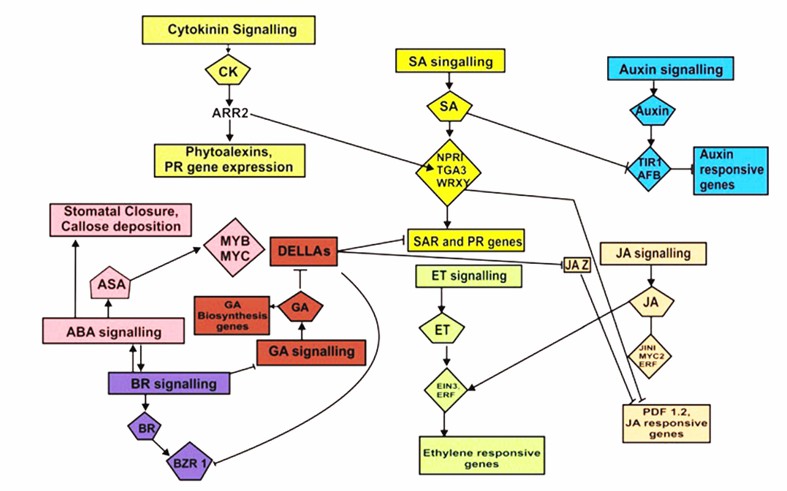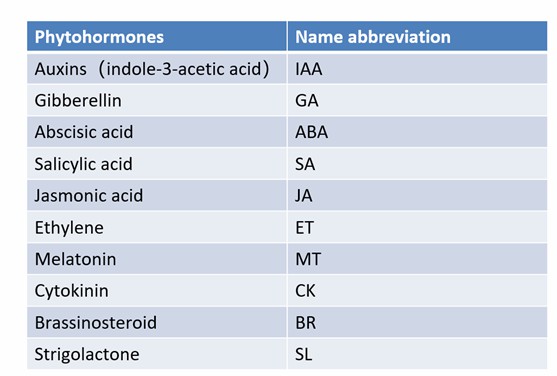Phytohormones play important roles in plant-pathogen interactions. Lifeasible provides services to support research on phytohormones in plant-pathogen interactions to pave the way for developing plant protection strategies based on phytohormones.
Phytohormones are not only involved in plant growth and development but are also important regulators of plant defense. In plant-pathogen interactions, these phytohormones coordinate their defense responses through synergism or antagonism. Abscisic acid (ABA), salicylic acid (SA), jasmonic acid (JA), and ethylene (ET) are key players in stress response (Fig. 1). A fundamental process in the mechanism of plant-pathogen interactions is regulating trophic divergence. Almost all types of phytohormones play essential roles in this regulatory system. Some hormones, such as gibberellin, cytokinin (CK), and brassinosteroid, are hormones that regulate trophic divergence and thus play important roles in plant-pathogen interactions. Overall, phytohormones are key factors in plant-pathogen interactions.
 Fig. 1 Cross talk of phytohormones in biotic stress tolerance (Checker et al., 2018).
Fig. 1 Cross talk of phytohormones in biotic stress tolerance (Checker et al., 2018).
Lifeasible offers services to help analyze phytohormonal changes in plant-pathogen interactions, and we also help to explore the role of phytohormones in plant-pathogen interactions.
Detection of phytohormones
We help to qualify and quantify the production of multiple phytohormones in plant-pathogen interactions. We have advanced ultra-performance liquid chromatography (UPLC), high-performance gas chromatography (HPGC), and mass spectrometry (MS) that we can use in combination to achieve high-performance analysis of various phytohormones. Below are the phytohormones that we test commonly (Table 1). Please let us know if you have any other requirements.
Table 1. Phytohormones.

In addition, we also help with the visualization of phytohormones and phytohormone responses. We rely on three main approaches to help visualize and analyze phytohormone and phytohormone responses in plant-pathogen interactions. We help genetically encode phytohormone indicators based on Förster Resonance Energy Transfer (FRET), construct phytohormone-mediated protein degradation or stabilization in plants, and construct phytohormone-responsive gene reporters, translational regulation, or promoter in plants. We have extensive experience in plant gene editing and can efficiently achieve plant phytohormones visualization by gene editing for studying the role of phytohormones in plant-pathogen interactions.
For a particular phytohormone, we can also help with phytohormone detection using biosensors or microelectrode. We help build unique sensors/microelectrodes and validate their sensitivity and selectivity based on UPLC-MS or gene expression. For example, we help construct Pt nanoflowers or electrochemically reduced graphene oxide (ERGO)-modified Pt microelectrodes to detect JA. We also have extensive experience in developing plant nano-sensors and can help implement the construction of plant hormone sensors.
Studying the role of phytohormones in plant-pathogens
We help study the role of phytohormones in plant-pathogen interactions. We help with the manipulation of phytohormone signaling by non-degradable corepressors, dominant mutations, and constitutively active transcription factors. We help with the modification of phytohormone receptors to disrupt the signal. We then help explore whether these alterations affect pathogen invasion.
We also help explore differences in phytohormones responses when pathogenic mutants invade plants to determine the role of phytohormones.
Lifeasible masters a wide range of methods for phytohormone detection and has extensive experience in plant protection, gene editing, and nano-sensor construction, which can help efficiently study the changes and explore the role of phytohormones in plant-pathogen interactions. Please contact us for professional services.
References